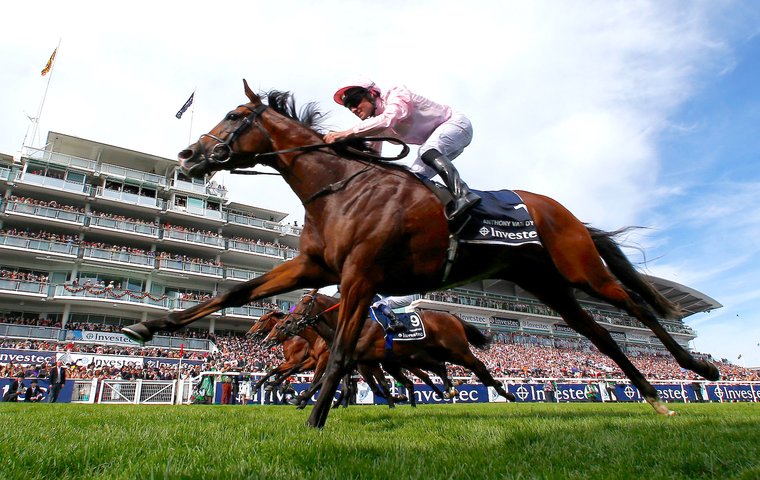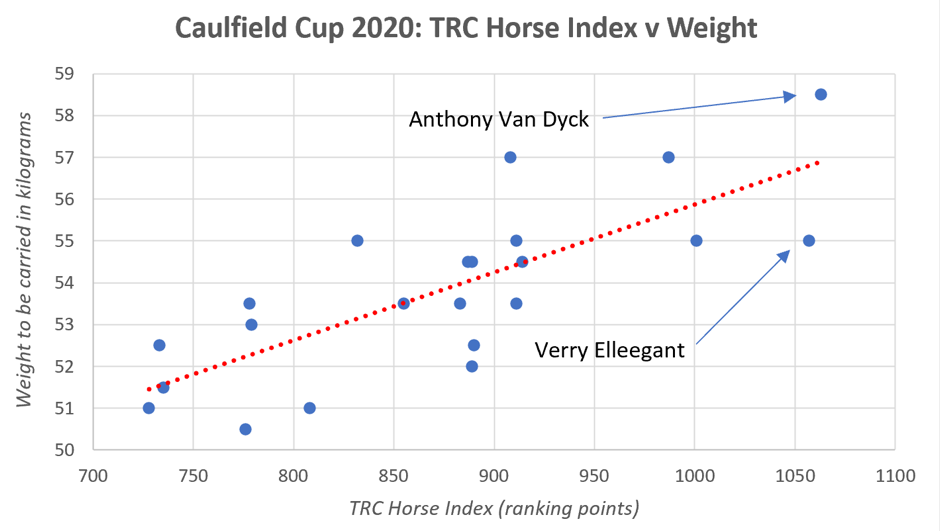
The traffic moves fast on the Road to the Melbourne Cup on November 3. In the few short weeks until then, we can leverage the power of TRC Global Rankings to examine a few of the key preps.
The Caulfield Cup, which takes place on Saturday, is our first exposure to some of the leading players. Run under handicap conditions for now, it takes place over a distance of a mile and a half (2400m) at Caulfield racecourse in Melbourne. The purse is A$5m (US$3.5m).
Here is how the field stacks up according to decreasing ranking, with the weight carried and the horse’s performance index after its name:
#83 Anthony Van Dyck 58.5kg 1063pts
#97 VerryElleegant 55kg 1057pts
#169 Buckhurst 55kg 1001pts
#195 Avilius 57kg 987pts
#403 DashingWilloughby 54.5kg 914pts
#413 Mirage Dancer 55kg 911pts
#413 Master Of Wine 53.5kg 911pts
#417 Vow And Declare 57kg 908pts
#486 Dalasan 52.5kg 890pts
#490 Prince Of Arran 54.5kg 889pts
#490 True Self 52kg 889pts
#499 Finche 54.5kg 887pts
#510 San Huberto 53.5kg 883pts
#651 The Chosen One 53.5kg 855pts
#782 Mustajeer 55kg 832pts
#914 ToffeeTongue 51kg 808pts
#1067 Warning 53kg 779pts
#1075 RaheenHouse 53.5kg 778pts
#1088 Chapada 50.5kg 776pts
#1350 Oceanex 51.5kg 735pts
#1369 Le Don De Vie 52.5kg 733pts
#1450 Aktau 51kg 712pts
As the weight each horse is set to carry is derived from its rating with the official handicapper, we have, in effect, two competing sets of rankings: the handicappers and ours. Let’s plot the two, with the TRC ranking on the x axis and the weight to be carried (i.e. the official handicapper’s rating) on the y. The red dotted line on the plot shows that the two sets of rankings are strongly correlated. In fact, the correlation coefficient between a horse’s TRC performance index and the weight it has to carry for this field is 0.768. Correlation coefficient is a dimensionless measure (it has no units) of the strength and direction of a linear relationship between two numerical arrays. Here, as expected, the relationship is strong and positive; that is, as TRC horse ranking of a Caulfield Cup aspirant increases, so too does the weight to be carried.
The red dotted line on the plot shows that the two sets of rankings are strongly correlated. In fact, the correlation coefficient between a horse’s TRC performance index and the weight it has to carry for this field is 0.768. Correlation coefficient is a dimensionless measure (it has no units) of the strength and direction of a linear relationship between two numerical arrays. Here, as expected, the relationship is strong and positive; that is, as TRC horse ranking of a Caulfield Cup aspirant increases, so too does the weight to be carried.
Now, at this point it is tempting to infer that, this being a handicap, horses represented by blue points that lie above the red line have more weight than justified by their TRC Global Ranking, while those below the blue line have less weight, and are thus ‘well handicapped’ and thus at an advantage.
But this doesn’t work in a predictive setting. The reality of the situation in the few handicaps run around the world at Group level is that differences between ranking points are a much bigger deal than differences in weight. In other words, the more weight a horse is set to carry, the better its chance.
Of course, more weight does not cause horses to win handicaps; that would run contrary to the laws of physics. Instead, what happens in handicaps is caused by humans worldwide assuming that racehorse merit lies on a linear scale and it can be assumed from measuring differences between runners at the end of a race.
This is wrong. And the handicapping system in most countries is broken. Handicappers say that their weights give horses an equal chance, but the truth is like the line from Animal Farm by George Orwell about some animals being more equal than others. The collateral form system is a model that has severe limitations when applied to try to predict future performance by neutralising differences in talent.
We can actually test this hypothesis in the Caulfield Cup after the race is run. If the handicapper has done a good job, the finishing order will be uncorrelated (or weakly correlated, at least) with the order of merit described by TRC Global Rankings, headed by Anthony Van Dyck and Verry Elleegant, because our rankings for the race make no allowance for the weight the horses carry. But, if our rankings are correlated with the finishing order, it will suggest that the handicapper’s scale of ratings should be stretched out further to give the better horses more weight to carry.
We will see.
Irrespective of that, the Caulfield Cup is one of the first races that provides vital clues as to how the Northern and Southern Hemisphere horses fit together. It is a very strong view of our rankings that Northern Hemisphere middle-distance and staying horses are not only superior to those in Australia, but that they are better than the handicapper’s figures describe they are. In other words, we contend that the raiders have a big advantage in handicaps like the Caulfield Cup and Melbourne Cup. And history seems to bear this out.
But that doesn’t apply to every horse in Australia, only it is a general rule. The mare Very Elleegant, for instance, is one exception as our figures above describe. She has won two of her three races at a mile and a half and is getting better in the current preparation, winning the G1 Turnbull last time from several of these.
We will stick to the format used for our Kentucky Derby Prep School series, identifying first the most likely winner and then a projected value horse among longer shots on the board.
MOST LIKELY WINNER Anthony Van Dyck
It isn’t necessary to add anything to the above explanation to further the claims of Aidan O’Brien’s super talented runner, winner of the 2019 G1 Derby at Epsom. He has mixed it with some of the best horses on the planet, beating #19 Stradivarius in the G2 Prix Foy at Longchamp and finishing in front of the same horse earlier in the year when second to #3 Ghaiyyath in the G1 Coronation Cup at Newmarket.
He isn’t the most consistent horse, it’s true, and sometimes he looks hard work in the finish, but one of the keys to him is a sound surface, which he figures to get this weekend, even though a little rain is in the forecast for Melbourne.
The obvious negative about his chance is the draw. It isn’t going to be easy for jockey Hugh Bowman to minimise ground-loss from stall 21, but these situations are easier to combat when you are on the back of the best horse. True, it weakens the betting case against Anthony Van Dyck in this spot, but it certainly does not relegate him from the status of the one to beat.
VALUE PICK Dashing Willoughby
The combination of a low draw, front-running speed and strong stamina makes Dashing Willoughby an interesting pick here. Known in Britain as mainly a stayer, he looks an interesting type for this reversion to a mile and a half. After all, he looked plenty pacey enough when winning a listed race over this trip at Newmarket in June, which didn’t count towards TRC Global Rankings for horses but helps to bolster his case as one of the better types in here.
Over staying trips, Dashing Willoughby has once or twice given the impression he doesn’t quite get home at two miles and above. When he won the G3 Henry II Stakes at Sandown over the trip, he raced freely and travelled strongly and came off as being quite a bit better than a length-and-a -quarter defeat of Spanish Mission. That horse is really talented (the form has worked out well) and to dismiss him comfortably says a lot about Dashing Willoughby.
Let’s see what he can do over this trip; it is unlikely that the market will factor in the potential for him to be suited by it.
How they rate for The Everest
The G1 Caulfield Cup isn’t Australia’s only great race on Saturday. While The Everest at Randwick, the richest turf race in the world, doesn’t yet have the same Graded status, it is certainly stacked with talented runners. In fact, by TRC Global Rankings, four of the top five horses in any division in the country line up for this AU$13 million (US$9.2m) sprint.
Here is a look at how the field of 12 declared runners (plus four reserves) ranks globally:
#13 Nature Strip
#28 Gytrash
#57 Santa Ana Lane
#68 Bivouac
#87 Behemoth
#102 Trekking
#131 Tofane
#239 Haut Brion Her
#273 Classique Legend
#340 Libertini
#383 Eduardo
#756 Dollar for Dollar
Reserves
#669 Deprive
#914 Standout
#980 Special Reward
#1949 Tactical Advantage
Nature Strip has good days and bad days, but he and the progressive Gytrash are the most talented runners in the line-up, according to our figures.


